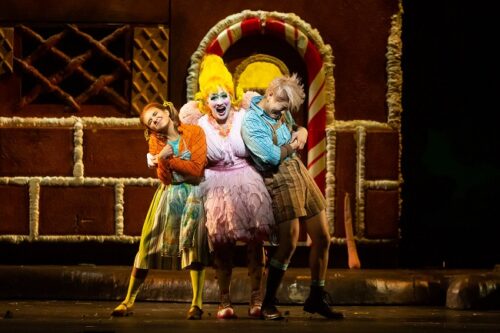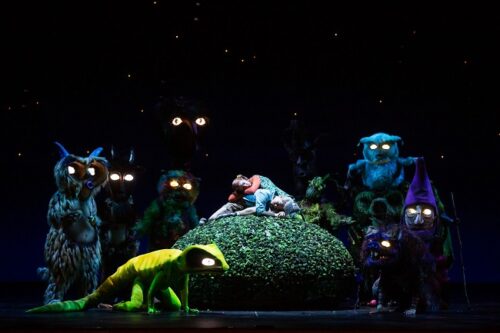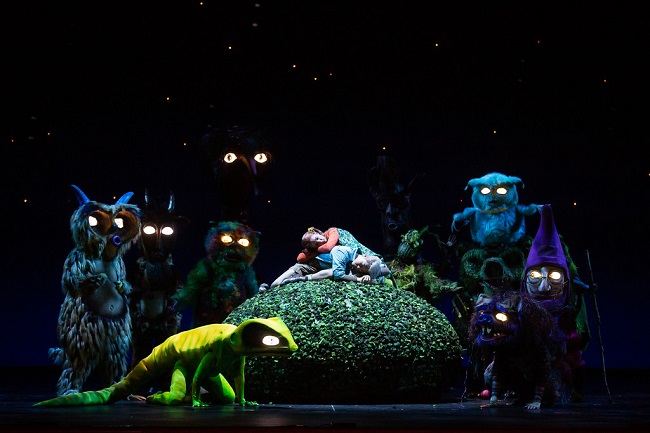 United States Humperdinck, Hansel and Gretel: Soloists, Children’s Chorus of the Greater Dallas Choral Society, The Dallas Opera Orchestra / Emmanuel Villaume (conductor). Livestreamed (directed by Tim Kelly) from the Margot and Bill Winspear Opera House, Dallas, 5.11.2022. (JPr)
United States Humperdinck, Hansel and Gretel: Soloists, Children’s Chorus of the Greater Dallas Choral Society, The Dallas Opera Orchestra / Emmanuel Villaume (conductor). Livestreamed (directed by Tim Kelly) from the Margot and Bill Winspear Opera House, Dallas, 5.11.2022. (JPr)

Production:
Translation – Richard Sparks
Director, Set and Costume designer – Doug Fitch
Original Lighting designer – Duane Schuler
Revival Lighting designer – Eric Watkins
Assistant director, Choreographer and Dance Captain – Austin Spangler
Principal conductor, Greater Dallas Choral Society – Terrie Preskitt-Brown
Cast:
Hansel – Kangmin Justin Kim
Gretel – Elena Villalón
The Witch and Mother – Patricia Racette
Father – Mark Delavan
Sandman – Lindsay Metzger
Dew Fairy – Gabrielle Gilliam
Solo Dancers – Kayleigh Eidson, Silken Kelly, J. Alexander Langley, Keon K. Nickie
There are a number of ways of now presenting Humperdinck’s Märchenoper (fairy-tale opera) Hansel and Gretel; a director can either ramp up the Gothic horror, or go for an ecological, anti-consumerist approach, or like Doug Fitch’s production for Dallas Opera (via Los Angeles Opera where it was first staged in 2006) revert to a children’s storybook look that has Disney cartoon and Sesame Street influences.
Humperdinck was born near Cologne in 1854 and in 1882 he was musical assistant to Richard Wagner helping to prepare the first Parsifal performances at Bayreuth. In the 1890s, his sister, Adelheid Wette, had written a libretto based on the Grimm fairy-tale, and asked her brother to set it to music as a Christmas entertainment for her children. Later, they decided to turn it into a full-scale opera and Hänsel und Gretel was premiered at Weimar on 23rd December 1893. It was an instant hit and has remained an enduring masterpiece. Humperdinck composed other operas but remained a victim of this first big success since nothing else he did quite matched up to it. Richard Strauss – who was the assistant conductor for the premiere – called it ‘a masterwork of the first rank’ but Humperdinck’s music owes so much to Wagner that the score is almost an affectionate parody of him at times. I seem to hear different things every time I see and hear Hansel and Gretel, this time I recognised Das Rheingold and Siegfried (especially the Forest Murmurs), though there was much else besides. I also believe there might be a direct quote from Mahler’s setting of the Wunderhorn poem Das irdische Leben with the similar topic of hunger that Hansel sings about. Both that and the opera were composed at the same time, and it would be interesting to know which actually was first: and all those cuckoos in the second act are surely not another Mahlerian coincidence. All three composers clearly knew each other well.
Director Doug Fitch’s designs are a delight and I suspect there was much more going during the overture than Tim Kelly’s cameras allowed us to see as they were fixated on the batonless conductor Emmanuel Villaume who nearly always had his head in his score and rarely looked up. All I particularly noticed was video of a flying broomstick and the first appearance of the purple gnome we hear about in Richard Sparks’s modern English translation, as well as a number of strange colourful creatures – most with large luminous eyes – some of whom were there to move parts of the set around. The religiosity of the original has been toned down and there are no longer 14 angels watching over the children at night and these are replaced by references to the beauty of nature and the protective spirits surrounding them onstage. Elsewhere, Hansel and Gretel’s famous dance-song became a ‘Rice Cream Dance’ with the line ‘With my tongue, I’ll lick, lick, lick’ where you might often hear something like ‘With my foot, I’ll tap, tap, tap.’
The opera begins with a relatively bare stage apart from the back wall of a small house and with everything apparently made with straw, there are two large chairs, an equally over-sized table (with a big jug) and an array of six broomsticks. The first Disney element comes when they dance alongside Hansel (blue shirt and lederhosen) and Gretel (orange-red top and yellow-striped skirt) and roam the stage. We first see the Mother as a huge face projected at the back before she appears for milk to be spilt and in her anger sends her children off to gather strawberries in the haunted forest. The theme of hunger rears its thought-provoking head as she sings ‘Please help me find food for my poor son and daughter’. The ruddy-cheeked Father earns a slap for being drunk but isn’t the wastrel he seems as he has had such a good day selling the brooms he makes and has bought the food they all need, including producing a string of sausages from his pocket and having ‘A cake for the children’. He is horrified to learn they are away in the forest where a witch now lives.
The timpani at the start of the ‘Witch’s Ride’ will make you think of the giants in Das Rheingold. As the sun went down, we see three giant red-capped toadstools whilst the gnome and other creatures keep watch over the children who cannot find their way home in the dark and are asleep on a bush. The Sandman flies in like the Woodbird in Siegfried and showers the children with glitter rather than sand. This ‘dream pantomime’ ends the first half.

The final act opens with the creatures slinking away and Hansel and Gretel being woken up by the Dew Fairy who looked like an angel atop a very large Christmas tree covered with white lights. A gingerbread house appears looking as if it is exactly the cottage of candy or cake described in Sparks’s translation. The Witch looks like Bette Davis in What Ever Happened to Baby Jane? a nightmarish sight (for adults if not for children) with a bright yellow wig which she later amusingly discards and rather short pink tulle skirt. Singing ‘Come, I beg you humbly won’t you join my fambly?’, the Witch wields a magic ladle and soon Hansel and Gretel are under her spell and she will turn Hansel into a blob. (I intend to finish this review by commenting on the musical performances but must mention here what great fun Patricia Racette – who also sang the children’s Mother – was obviously having as the Witch flying above the stage on her broom.)
Soon Gretel grabs the ladle and releases Hansel from the spell he is under, before – rather too easily – the Witch is conned into climbing into her oven and she is despatched with more of a whimper than a bang. Gingerbread figures fill the stage and are turned back into children with a touch of Gretel’s ladle and Hansel and Gretel greet their parents enthusiastically. The opera ends with all the saved children together with the Father proclaiming ‘For our spirits did not fail, so, we lived to tell the tale!’
The production was fresh and performed with great commitment by its cast and their singing – as heard through loudspeakers – was well-matched by their acting. This Hansel and Gretel benefited enormously from having the sweet-toned countertenor Kangmin Justin Kim as a genuinely boyish Hansel to Elena Villalón’s suitably girly Gretel. They seemed to thoroughly enjoy all the childish rough-and-tumble at the start and throughout the opera their voices blended perfectly. After Villalón’s Gretel is awakened by the Dew Fairy she sang her greeting to the new day and displayed some exquisite high notes. Patricia Racette was the stern Mother and an absolute hoot as the Witch, her soprano may not have the vocal quality of earlier in her career but she hocused-pocused very entertainingly. In his opening song Mark Delavan was a believable drunk as he extolled the delights of beer and when producing all the food he has bought appeared less feckless than the character sometimes can. Delavan’s authoritative bass-baritone oddly seemed to have a little trouble cutting through the children’s chorus and Humperdinck’s orchestration in the final moments. Humperdinck gives the Sandman and Dew Fairy chances in this opera that it is virtually impossible to fail in and the limpid voices of Lindsay Metzger and Gabrielle Gilliam made the absolute best of their opportunities.
Music director Emmanuel Villaume obtained a bewitching performance from his Dallas Opera Orchestra that had perfectly judged tempos and was lovingly nuanced with all the Wagnerian colourations in Humperdinck’s melodic score brought into wonderfully focused detail.
The livestream had a full programme of interesting content before and after the opera, as well as during the interval, and for information about any future operas on the Dallas Opera streaming service click here.
Jim Pritchard
